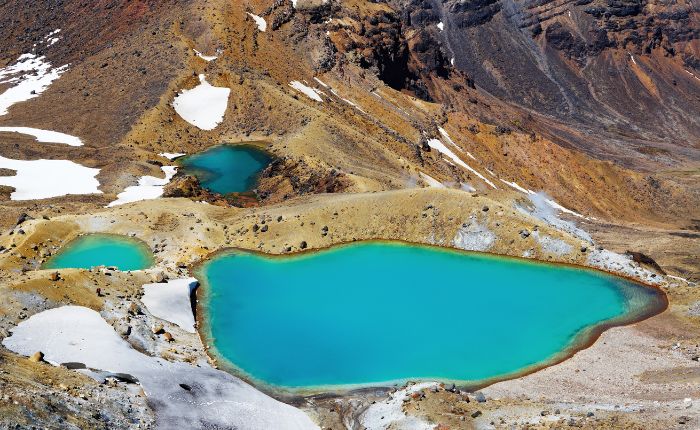Welcome to the 7 Lakes Trek in Himachal Pradesh, a spectacular excursion that reveals Himachal Pradesh’s unspoiled beauty. This incredible walk takes you through the scenic landscapes of the Dhauladhar ranges, where the calm and natural splendour of seven magnificent high-altitude lakes will enchant you.
Let’s go into the specifics of this incredible journey.
Location
The 7 Lake Trek is Sacred Lake Treks located in Himachal Pradesh’s mesmerising Dhauladhar hills. This lovely area is close to McLeod Ganj, a quaint hill station noted for its Tibetan culture and peaceful environs. The trail winds through valleys, alpine meadows, and rocky terrains, providing the ideal combination of adventure and natural beauty.

Duration and Difficulty Level
The trek takes 8-10 days to complete, depending on the schedule and your pace. It is a moderately difficult hike recommended for experienced trekkers or those in good physical condition. The trail includes steep ascents, narrow slopes, and harsh terrain, all of which need energy and acclimatisation to high altitudes.
Day-Wise Itinerary
Join me on an exciting adventure as I tell my firsthand experience trekking over the breathtaking seven high-altitude lakes of the Dhauladhar ranges. This breathtaking adventure led me through some of the most beautiful landscapes, immersing me in the peace and natural beauty that this region has to offer.
Let’s have a look at the day-by-day itinerary and relive the enchantment of this memorable journey.
Day 1: Arrival in McLeod Ganj
No trekking involved.
After arriving at McLeod Ganj, a picturesque Himachal Pradesh hill station, I spent the day learning about Tibetan culture and preparing for the hike ahead. The lively markets and serene monasteries set the tone for the journey ahead.
Day 2: McLeod Ganj to Triund (2,875m)
Distance: Approximately 9 kilometers
Trekking Time: 4-5 hours
The hike began with a gentle elevation from McLeod Ganj to Triund. The trail was lined by extensive forests of oak and rhododendron, which provided welcome shade. When I arrived in Triund, I was greeted with stunning views of the Kangra Valley and the majestic Dhauladhar peaks.
Day 3: Triund to Lahesh Cave (3,500m)
Distance: Approximately 6 kilometers
Trekking Time: 3-4 hours
As we made our way to Lahesh Cave, the trail took us through rugged terrain. The vistas changed into a rough beauty as the altitude ascended. The campground at Lahesh Cave provided breathtaking vistas of the snow-capped peaks, and the cool mountain air exhilarated us.
Day 4: Lahesh Cave to Indrahar Pass (4,350m) to Chhata Parao (3,500m)
Distance: Lahesh Cave to Indrahar Pass – Approximately 5 kilometers
Trekking Time: 3-4 hours (one way)
Distance: Indrahar Pass to Chhata Parao – Approximately 8 kilometers
Trekking Time: 5-6 hours
We set out on a difficult but rewarding hike from Lahesh Cave to Indrahar Pass, the trail’s highest point. The panoramic views of the neighbouring peaks and valleys were breathtaking. Descending down the pass, we arrived at the picturesque Chhata Parao campground, surrounded by beautiful green fields.
Day 5: Chhata Parao to Kuarsi (3,250m)
Distance: Approximately 12 kilometers
Trekking Time: 6-7 hours
The path from Chhata Parao took us through a beautiful valley studded with brilliant wildflowers and rushing streams. As we entered Kuarsi, we were met by the tranquil sight of the trek’s first lake, Lam Dal. Its crystal-clear waters mirrored the neighbouring mountains, enthralling us.
Day 6: Kuarsi to Chandratal (4,300m)
Distance: Approximately 15 kilometers
Trekking Time: 7-8 hours
The journey to Chandratal, a magnificent crescent-shaped lake famed for its ethereal beauty, was the highlight of the trek. The trail wound through alpine meadows, and the vista of Chandratal flanked by snow-capped peaks was out of this world.
Day 7: Chandratal to Chatru (3,200m)
Distance: Approximately 14 kilometers
Trekking Time: 6-7 hours
We dropped towards Chatru, leaving the magnificent Chandratal behind, travelling through bleak landscapes and stony terrains. Chatru served as a base camp for several other treks and provided a beautiful view of the surrounding valleys and rivers.
Day 8: Chatru to Manali
Distance: Approximately 80 kilometers (by road)
Travel Time: Around 4-5 hours (by road)
The last stage of our journey took us from Chatru to Manali. The route included magnificent vistas and twisting roads, with views of the massive Rohtang Pass and the Beas River. We celebrated the end of this fantastic adventure when we arrived at Manali.
Note: Please note that the distances and trekking times provided are approximate and can vary depending on individual walking speed and trail conditions.
Key Lakes:
The 7 Lakes Trek provides a gateway to enjoying the Himalayas’ pristine beauty and tranquillity. Each lake along the trail has its own distinct charm, enchanting trekkers with its ethereal beauty and quiet ambiance.
Lam Dal:
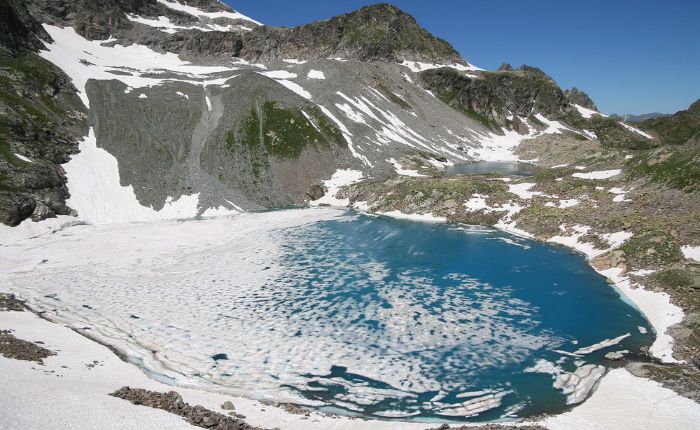
Lam Dal, the first lake met on the walk, has a distinct beauty. This gorgeous lake, set among alpine meadows, features crystal-clear waters that reflect the snow-capped peaks of the surrounding Dhauladhar ranges. The quiet ambiance of Lam Dal is ideal for trekkers looking to unwind and immerse themselves in nature’s serenity.
Nag Dal:
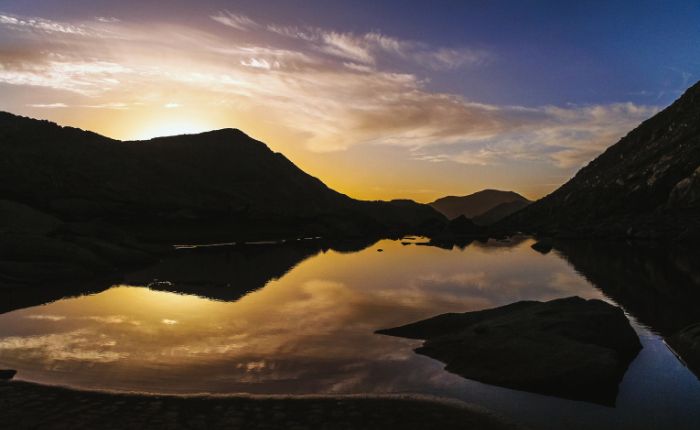
Nag Dal, the trek’s second lake, has unique importance. Its name, which translates to “Snake Lake,” comes from the idea that Nag Devta (the Snake God) lives in the lake. Nag Dal’s blue waters stand out against the surrounding flora and rocky environment. Trekkers frequently stop here to take in the tranquil beauty and to hear the legends related with the famous Nag Devta.
Kareri Lake:
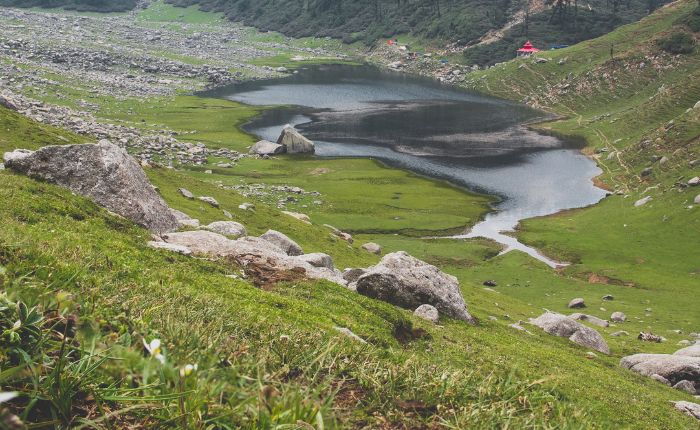
Kareri Lake, tucked in the Dhauladhar hills, is a hidden treasure on the 7 Lakes Trek. This glacial lake, surrounded by beautiful green meadows, deep forests, and towering mountains, provides a breathtaking view. According to legend, Lord Shiva meditated on the banks of Kareri Lake, endowing it with a supernatural aura. The peaceful atmosphere and breathtaking views make it a must-see destination for hikers.
Chanderkhani Pass Lake:
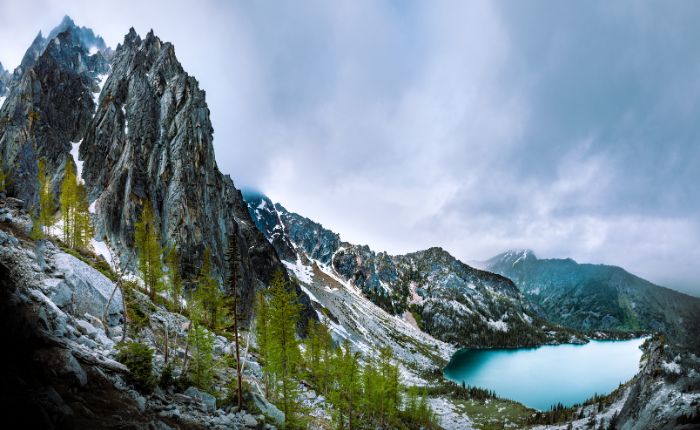
This lake, located near the beautiful Chanderkhani Pass, is breathtaking. Trekkers are rewarded with a varied scenery that includes vivid meadows, lush forests, and breathtaking mountain ranges. The lake’s tranquil waters and surrounding surroundings provide a nice break for tired hikers. Legends tell of divine entities visiting this lake, adding to its enchantment.
Prashar Lake:
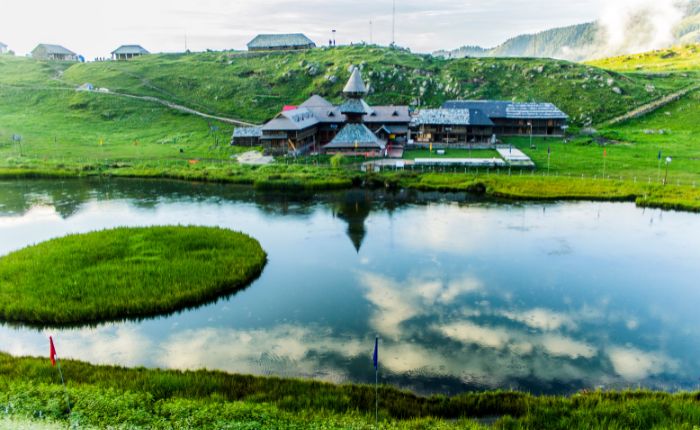
Prashar Lake is steeped in folklore and tradition, nestled among deep forests and towering peaks. The Pandavas, heroes of the epic Mahabharata, are thought to have created it. The emerald-blue waters of the lake fascinate visitors, while a neighbouring temple dedicated to the philosopher Prashar gives a spiritual touch to the tranquil surroundings. Prashar Lake’s natural beauty set against the backdrop of snow-capped peaks gives a really magical experience.
Dashaur Lake:
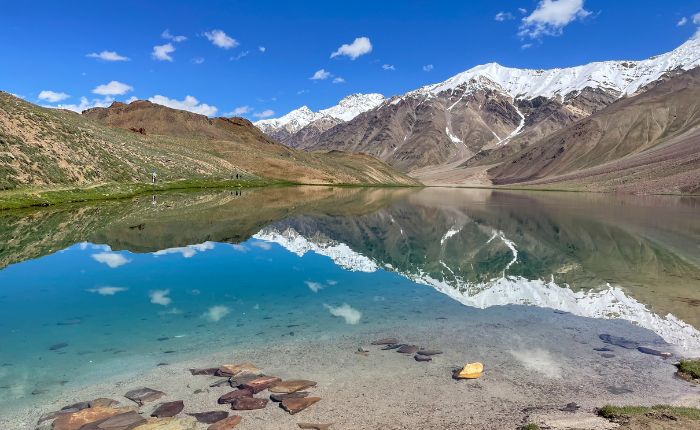
Dashaur Lake, situated among alpine meadows and encircled by high peaks, provides a peaceful haven. The tranquillity of the lake and the rocky grandeur of the Dhauladhar hills greet trekkers. The local deities are claimed to have blessed this pristine lake, and its peaceful waters provide a sense of peace and harmony.
Brighu Lake:
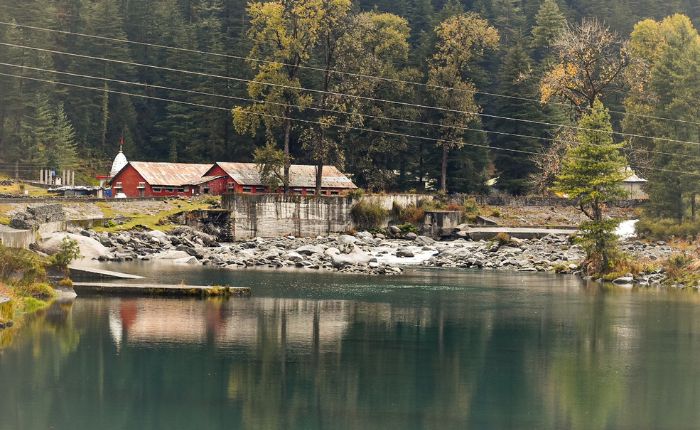
Brighu Lake, the trek’s crowning achievement, is deeply religious in nature. The sage Brighu is said to have pondered near the lake, making it a popular pilgrimage destination. Brighu Lake is located in the Himalayas and offers panoramic views of snow-capped peaks, green valleys, and alpine meadows. Trekkers are frequently taken aback by its beauty and the sense of tranquillity it provides.
Trekking Essentials: Prepare for the Adventure Ahead
The 7 Lakes Trek necessitates careful planning and packing of vital materials. Here’s a thorough list of gear and equipment to consider for a safe and enjoyable trek:
- Pack only the necessities to reduce weight and maximise comfort on the hike.
- Select lightweight, quick-drying clothing to eliminate the need for frequent changes.
- Layer your apparel to accommodate changing temperatures and weather conditions.
- To avoid discomfort and blisters, test and break-in your hiking footwear before the walk.
- To prepare physically for the trek, engage in regular cardiovascular activities, weight training, and trekking.
- Increase your fitness gradually by doing pre-trek activities and walking on steep terrain.
- To maximise your physical endurance, stay hydrated and eat a balanced meal in the days leading up to the hike.
- During the walk, take many breaks to relax, refuel, and enjoy the scenery.
Remember that good planning, essential equipment, and physical fitness are vital for a pleasurable and safe hiking experience. You will be able to fully appreciate the delights of the 7 Lakes Trek in Himachal Pradesh if you are well-equipped and physically prepared.
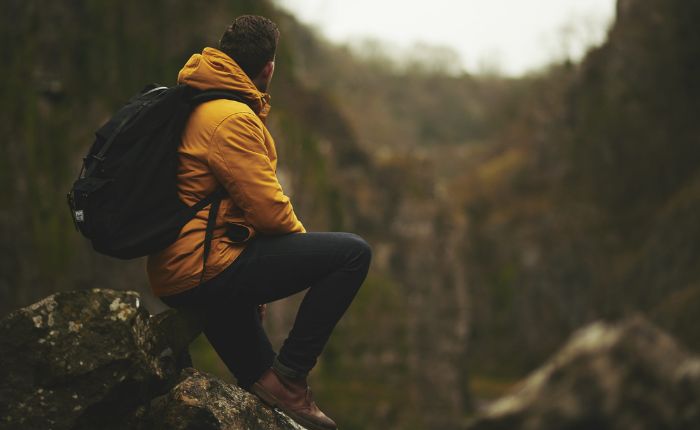
Hey wait✋🏽
Did you know you can rent the trekking & Camping accessories?
Permits and Regulations: Ensuring a Responsible Trekking Experience
Permits and Permissions:
- To enter the Dhauladhar forest area, every trekker must obtain permission from the Forest Department. They impose a cost of Rs. 300 each day. If you go with a trekking company, they will secure this authorization on your behalf and include it in the cost per person.
- Identification documents, such as a valid government-issued ID or passport, should be carried with you because they may be necessary for acquiring permissions or for checkpoint inspections.
Local Regulations and Guidelines:
- To reduce environmental effect and conserve the natural habitat, stick to authorised trekking trails and avoid deviating from them.
- Local culture and traditions should be respected. Dress modestly and exercise caution when visiting religious places or dealing with local people.
- Only camp in approved locations and adhere to Leave No Trace standards by packing out all trash and leaving campsites clean.
- Avoid disturbing or harming wildlife or their habitats. Maintain a safe distance and view animals from a safe distance without stressing or harming them.
- Fires should only be lit in approved places, and they should be completely extinguished before leaving the campsite.
Conservation of the Environment and Responsible Trekking Practises:
- Carry a reusable water bottle and employ water purifying technologies instead of purchasing single-use plastic bottles to reduce plastic waste.
- Respect the environment by not plucking flowers, destroying plants, or disturbing wildlife.
- Conserve water by utilising it wisely and avoiding waste on the walk.
- Purchase local items, hire local guides or porters, and respect their customs and traditions to help local communities.
- Educate yourself on the delicate ecosystem and the necessity of environmental conservation and share your knowledge with your fellow trekkers.
Note: Please keep in mind that individual permits and rules may vary, therefore it is best to check with local authorities, trekking agencies, or experienced guides for the most up-to-date information and recommendations on permits and appropriate trekking practises for the Himachal Pradesh 7 Lakes Trek.
Safety and Difficulties:
- The 7 Lakes Trek is an unforgettable trip, but it’s critical to be aware of potential hazards and prioritise safety throughout the journey. Here are some precautions and safety suggestions for hikers:
- The walk includes ascents to high heights, which can be difficult for trekkers. Acclimatisation is essential for avoiding altitude-related ailments.
- Ascend gradually, giving your body time to acclimatise to the altitude. To aid acclimatisation, avoid quick height gains and plan rest days.
- Stay hydrated by drinking plenty of water and avoiding excessive alcohol or caffeine use, all of which can contribute to dehydration.
- Take note of your body’s cues. If you encounter altitude sickness symptoms such as headache, dizziness, nausea, or shortness of breath, descend to a lower altitude and, if required, seek medical attention.
- In the mountains, the weather can be unpredictable. Prepare for rapid temperature swings, rains, and possibly snowfall, especially at higher elevations.
- Carry layers of clothing to accommodate changing weather and temperature swings.
Best Time to Visit:
The 7 Lakes Trek in Himachal Pradesh is best done throughout the summer and autumn months, namely from May to October. This is why:
Weather Conditions:
- Summer (May to June): The weather is nice throughout these months, with moderate daytime temperatures ranging from 15°C to 25°C (59°F to 77°F). Evenings can be cool, especially at higher elevations. The likelihood of precipitation is low, resulting in clear sky and excellent visibility.
- Autumn (September through October): Clear skies, pleasant temperatures, and consistent meteorological conditions characterise this season. The days are comfortable, with temperatures ranging from 10°C to 20°C (50°F to 68°F), while the nights become cooler as October approaches. Autumn provides spectacular views of vibrant foliage, adding to the whole trekking experience.
Accessibility:
The trekking trails and campsites are more accessible throughout the summer and autumn months. The snow melts, revealing the paths and making it easier to explore the terrain. It lessens the likelihood of meeting blocked paths or difficult conditions due to snowfall or landslides.
Lakes’ Beauty:
When the lakes are not frozen, you can fully enjoy their natural beauty and solitude. The lakes are most bright, reflecting the surrounding landscapes and mountains and creating a lovely scene. The pure waters, verdant meadows, and the play of light on the lakes provide spectacular views and unforgettable experiences.
Conclusion:
The Himachal Pradesh 7 Lakes Trek is an exciting trip through beautiful landscapes, tranquil lakes, and spectacular mountain panoramas. This trip is an adventure that immerses trekkers in the natural beauty and tranquillity of the Dhauladhar hills. Each lake has its own unique appeal, reflecting the grandeur of the surrounding mountains and providing an unparalleled sense of tranquillity.
Allow the call of the Seven Lakes Trek to reverberate within you. Lace up your boots, gather your belongings, and set out on this remarkable voyage that will leave an unforgettable stamp on your spirit. Himachal Pradesh’s beautiful lakes and breathtaking scenery are waiting to inspire, astonish, and nourish your spirit.
Important Question you need to Know:
What are the 7 lakes of Dhauladhar?
Lam Dal, Kareri Lake, Nag Dal, Chanderkup Lake, Kamrunag Lake, Brighu Lake, and Indrahar Pass Lake are the seven lakes of Dhauladhar in Himachal Pradesh, each with its own beauty and charm.
What is the 7 lakes Trek?
The 7 Lakes Trek is a captivating hiking trail in the Dhauladhar ranges of Himachal Pradesh, India, connecting seven high-altitude lakes known for their natural beauty and tranquility.
Which is the most difficult trek in Himachal Pradesh?
The Pin Parvati Pass Trek is one of Himachal Pradesh’s most difficult treks, known for its steep ascents, high altitude, and rough terrain.
Which is the longest trek in Himachal Pradesh?
The Great Himalayan National Park journey is Himachal Pradesh’s longest journey, stretching over 90 kilometres and passing through different landscapes and inaccessible mountainous regions.


